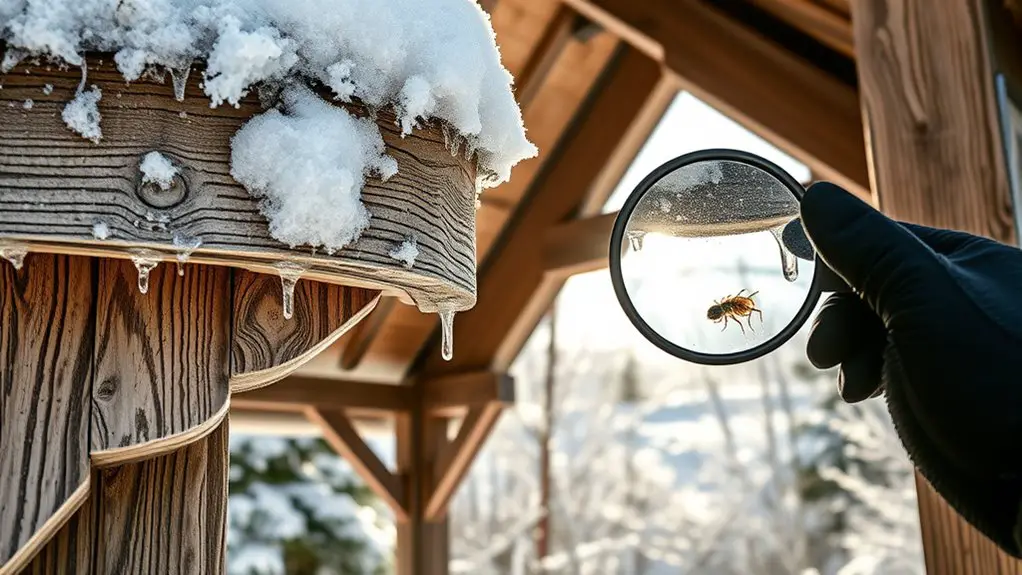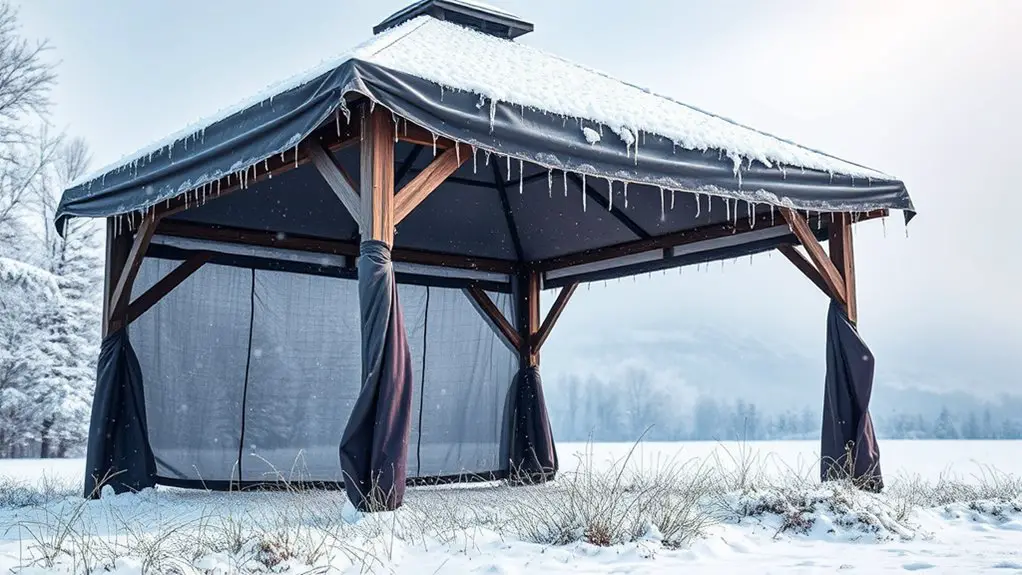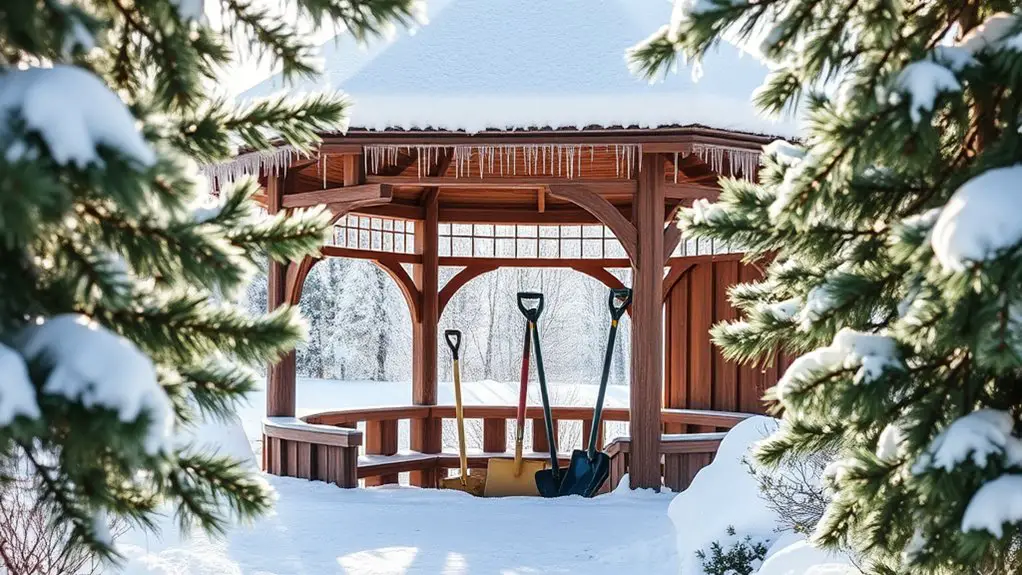To maintain your gazebo during winter, regularly inspect the structure for cracks and secure joints. Clear debris from the roof and gutters to prevent water damage. Use a roof rake to manage snow accumulation. Check for signs of pests and treat wood surfaces with high-quality sealants to protect against moisture and UV rays. Cover your gazebo with durable, breathable tarps, and guarantee proper drainage. By following these steps, you’ll set the stage for effective spring maintenance ahead.
Inspect Your Gazebo Structure

To keep your gazebo standing strong, regularly inspecting its structure is essential. During winter, the harsh elements can compromise gazebo stability, so you’ll want to be thorough. Start by checking for any visible cracks or signs of wear in the wood or metal. Pay attention to joints and fasteners, making sure they’re secure and free from rust. If you spot any loose boards or panels, tighten or replace them immediately.
Next, assess the foundation. Look for any shifting or settling that could affect balance. Snow accumulation can add significant weight, so verify your structure can handle it. If your gazebo has a roof, inspect it for sagging or broken shingles as well—this could lead to water damage. Additionally, regular inspections of securing systems are necessary to ensure that your gazebo is properly anchored and can withstand winter winds.
Clean the Roof and Gutters
Cleaning the roof and gutters of your gazebo is essential for preserving its longevity and aesthetic appeal. Regularly removing debris prevents moisture buildup that could lead to damage, while a thorough check for any signs of wear guarantees you catch problems early. Clearing the gutters not only maintains proper drainage but also protects your gazebo from potential water-related issues.
Remove Debris Regularly
One of the simplest yet most essential tasks for gazebo maintenance is removing debris regularly from the roof and gutters. By making this a part of your maintenance schedule, you’ll guarantee your gazebo remains a serene retreat. Various debris types, like leaves, twigs, and even dirt, can accumulate, blocking water flow and causing potential damage. Schedule a bi-weekly check during winter to clear these obstructions. Use a soft brush or a leaf blower to avoid damaging your roof. Remember, a clean gazebo not only looks inviting but also prevents issues down the road. Embrace this small task, and enjoy the freedom of a well-maintained outdoor space where you can unwind and connect with nature without worry.
Check for Damage
Regularly checking for damage on your gazebo is essential to its longevity and functionality. By performing seasonal inspections, you can catch potential issues early and take preventative measures. Here’s a checklist to guide your inspection:
- Inspect the Roof: Look for missing shingles or leaks that could lead to water damage.
- Examine the Structure: Check for any cracks or rot in the wood, as this can weaken the integrity.
- Assess the Hardware: Confirm bolts and screws are tight; replace any that are rusted or damaged.
- Look for Pests: Watch for signs of insect infestations that can compromise your gazebo’s materials.
Taking these steps can help you maintain a safe and beautiful outdoor space for years to come.
Clear Gutters Thoroughly
While it might seem like a minor detail, clearing your gazebo’s gutters and roof is essential for preventing water damage and structural issues. During winter, debris can accumulate, obstructing water drainage and leading to ice dams that threaten the integrity of your gazebo. You’ll want to prioritize gutter cleaning by removing leaves, twigs, and any other detritus that’s found its way in. Use a sturdy ladder to safely access the roof and gutters, ensuring you have the right tools at hand. Once you’ve cleared the gutters, check for any potential leaks or cracks that could worsen over time. Taking these steps will not only maintain your gazebo but also give you peace of mind as you enjoy your outdoor space year-round.
Remove Snow and Ice Regularly
As winter sets in, it’s vital to keep an eye on the snow piling up on your gazebo roof. Using a roof rake not only helps in removing the weight but also prevents potential structural damage that can occur from ice accumulation. Regularly checking the integrity of your gazebo guarantees it remains a safe and enjoyable space throughout the season. Additionally, be mindful of the maximum weight capacity for snow accumulation as specified by the manufacturer to avoid risking structural integrity.
Use a Roof Rake
If you want to protect your gazebo from the heavy weight of snow and ice, using a roof rake is essential. Regularly removing snow accumulation helps prevent damage and prolongs your gazebo’s lifespan. Here’s how to effectively use a roof rake for roof protection:
- Choose the Right Rake: Opt for a lightweight, telescoping roof rake that’s easy to handle.
- Timing is Key: Clear snow after each snowfall to prevent heavy buildup.
- Work from the Ground: Stay safe by raking from the ground, avoiding ladder use whenever possible.
- Be Gentle: Use a soft edge to avoid damaging shingles or roofing materials.
Check Structural Integrity
Regularly checking the structural integrity of your gazebo is just as important as removing snow and ice. During winter inspections, focus on a thorough structural assessment, examining beams, joints, and supports for any signs of stress. Snow and ice can accumulate weight, potentially compromising your gazebo’s foundation. Pay attention to any visible cracks or warping, as these can signal deeper issues. Don’t forget to clear the roof regularly, which alleviates unnecessary pressure on the structure. By staying proactive, you guarantee that your gazebo remains a sanctuary of freedom, ready for use come spring. Taking these steps prevents costly repairs later, allowing you to enjoy your outdoor space without worry. Embrace the beauty of winter while safeguarding your cherished retreat.
Check for Pest Infestations

How often do you inspect your gazebo for pesky intruders? Regular checks are essential for pest identification and effective infestation prevention. Winter can be a prime time for unwelcome guests, so follow these steps to keep your space free of nuisances:
Regular inspections of your gazebo are crucial during winter to prevent pest infestations and ensure a welcoming space.
- Inspect for Signs: Look for droppings, nests, or chewed materials.
- Check Crevices: Examine joints, corners, and any small openings where pests might enter.
- Clear Debris: Remove leaves and clutter that can attract pests or provide shelter.
- Seal Up: Make sure all gaps are tightly sealed to deter potential infestations.
Treat and Seal Wood Surfaces
While you might admire the natural beauty of your gazebo’s wooden surfaces, neglecting to treat and seal them can lead to serious deterioration over time. To maintain that rustic charm, it’s essential to invest time in wood treatment. Start by cleaning the surfaces thoroughly to remove dirt and grime, allowing the wood to breathe and absorb treatments effectively.
Once cleaned, choose high-quality sealing products specifically designed for outdoor wood. These products not only enhance the wood’s appearance but also protect it from moisture, UV rays, and pests. Apply the treatment evenly, ensuring every nook and cranny is covered. Regularly checking for water damage is also crucial to preserve the wood’s integrity.
Don’t rush this process; let the wood dry completely before applying a second coat, if necessary. By treating and sealing your gazebo, you’ll preserve its integrity and prolong its life, allowing you to enjoy its beauty and freedom for years to come.
Protect With Covers or Tarps

Even with well-treated wood, your gazebo can still be vulnerable to the elements. To guarantee it stands strong through winter, consider investing in protective covers or tarps. Here’s a breakdown of effective cover types and tarp materials to keep your gazebo safe:
Protect your gazebo from winter’s harsh elements with durable covers and tarps for lasting strength and beauty.
- Heavy-Duty Tarps: These offer superior durability and water resistance, ideal for harsh conditions.
- Breathable Covers: Prevent moisture buildup, reducing the risk of mold and mildew.
- UV-Resistant Fabrics: Protect your gazebo from sun damage, extending its lifespan.
- Custom-Fit Covers: Tailored to your gazebo’s dimensions, they provide a snug fit, minimizing wind resistance.
Choosing the right combination of cover types and tarp materials can make all the difference. By taking these protective measures, you’ll maintain your gazebo’s integrity and enjoy it for years to come, embracing the freedom of outdoor living even in winter. Additionally, ensuring that your gazebo is made from waterproof materials can significantly enhance its protection against winter weather.
Ensure Proper Drainage
To keep your gazebo in top condition, guaranteeing proper drainage is essential, especially after heavy rains or snowfall. Standing water can lead to mold, decay, and structural damage, undermining the freedom and enjoyment you seek in your outdoor space. Assess your gazebo’s location and landscaping; natural slopes can direct winter runoff away from the structure.
Consider implementing effective drainage solutions, like French drains or gravel beds, to channel water efficiently. If your gazebo has a floor, guarantee there are drainage gaps or holes to prevent water accumulation. Regularly check gutters and downspouts, clearing any debris that could obstruct flow. Additionally, ensure that your gazebo is properly anchored to withstand harsh winter conditions, minimizing the risk of damage from heavy snowfall or strong winds.
In heavy snow regions, promptly remove snow build-up from the roof to reduce pressure and limit melting runoff that could pool around your gazebo. By taking these steps, you’ll protect your investment and maintain a welcoming retreat for seasons to come.
Store Furniture and Accessories
When you think about maintaining your gazebo, storing furniture and accessories during harsh weather is just as essential as ensuring proper drainage. Proper furniture storage protects your investment and prolongs the life of your outdoor pieces. Here’s how to efficiently organize your accessories:
- Clean Thoroughly: Wipe down all surfaces to remove dirt and moisture before storage.
- Disassemble When Possible: Take apart larger furniture to save space and prevent damage.
- Utilize Storage Bags: Invest in waterproof storage bags for cushions and small accessories to keep them dry and mold-free.
- Organize by Use: Group similar items together, so you can easily access them when spring rolls around. Additionally, regular cleaning of your gazebo furniture before storage helps prevent mould and staining, ensuring they remain in good condition.
Plan for Spring Maintenance
As the winter chill fades and you prepare to uncover your gazebo, planning for spring maintenance is key to guaranteeing it remains a welcoming retreat throughout the warmer months. Start your spring preparations by reviewing your seasonal checklists. Inspect the structure for any signs of wear, like loose screws or cracked wood. Cleaning the surfaces is essential; a gentle wash will keep mold and mildew at bay, especially if you consider hiring a professional for extensive mould removal if necessary.
Don’t forget to check the roof for debris or damage, as this can lead to leaks. Verify your gazebo’s paint or stain is intact, applying a fresh coat if necessary to protect against the elements.
Finally, consider the landscaping around your gazebo. Trimming back overgrowth not only enhances aesthetics but also prevents unwanted pests. By being proactive with your spring maintenance, you’ll create an inviting space that invites relaxation and freedom all season long.
Frequently Asked Questions
Can I Use a Pressure Washer to Clean My Gazebo?
You can use a pressure washer for gazebo cleaning, but make certain you prioritize pressure washer safety. Choose appropriate settings and techniques to avoid damaging the wood or materials, maintaining your gazebo’s beauty without sacrificing its integrity.
What Materials Should I Avoid When Covering My Gazebo?
When covering your gazebo, avoid vinyl covers and heavy tarps. They trap moisture, leading to mold and damage. Instead, opt for breathable materials that allow air circulation, ensuring your gazebo stays protected and dry throughout the seasons.
How Often Should I Check for Pests During Winter?
Did you know nearly 30% of homes face pest issues during winter? For effective pest prevention, conduct winter inspections every month. Regular checks help you maintain a pest-free environment, ensuring your outdoor space remains inviting and enjoyable.
Is It Safe to Use Heat Lamps Inside the Gazebo?
Using heat lamps inside your gazebo can be risky. Guarantee proper gazebo insulation to prevent fire hazards. Always prioritize heat lamp safety; monitor for overheating, and maintain adequate ventilation to enjoy your space without worry.
What Temperature Is Too Cold for Gazebo Maintenance?
When it’s colder than a polar bear’s toenails, you should avoid gazebo care. Winter temperatures below 32°F can lead to damage. It’s best to wait for milder conditions to guarantee your gazebo stays in top shape.

